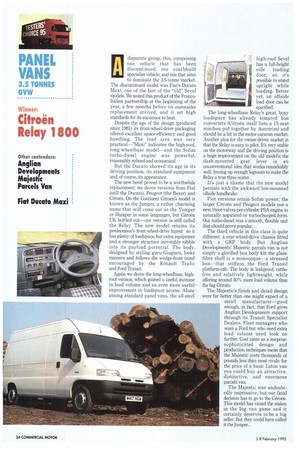PANEL VANS
Page 36

If you've noticed an error in this article please click here to report it so we can fix it.
3.5 TONNES GVW
A disparate group, this, comprising
one vehicle that has been discontinued; one coachbuilt specialist vehicle; and one that aims to dominate the 3.5-tonne market.
A disparate group, this, comprising
one vehicle that has been discontinued; one coachbuilt specialist vehicle; and one that aims to dominate the 3.5-tonne market.
The discontinued model was Fiat's Ducato Maxi, one of the last of the "old" Sevel models. We tested this product of the FrancoItalian partnership at the beginning of the year, a few months before its namesake replacement arrived, and it set high standards for its successor to beat.
Despite the age of the design (produced since 1981) its front-wheel-drive packaging offered excellent space-efficiency and good handling. The load area was very practical—"Maxi" indicates the high-roof, long-wheelbase model—and the Sofim turbo-diesel engine was powerful, reasonably refined and economical.
But the Ducato showed its age in its driving position, its standard equipment and, of course, its appearance.
The new Sevel proved to be a worthwhile replacement; we drove versions from Fiat (still the Ducato), Peugeot (the Boxer) and Citroen. On the Continent Citroen's model is known as the Jumper, a rather charming name that will come out as the Yumper or Humper in some languages, but Citroen UK bottled out—our version is still called the Relay. The new model retains its predecessor's front-wheel-drive layout so it has plenty of loadspace, but extra equipment and a stronger structure inevitably nibble into its payload potential. The body, designed by styling guru Giugiaro, looks massive and follows the wedge-front trend encouraged by the Renault Trafic and Ford Transit.
Again we drove the long-wheelbase, highroof version, which gained a useful increase in load volume and an even more usefulimprovement in loadspace access. Alone among standard panel vans, the all-steel high-roof Sevel has a full-height side loading door, so it's possible to stand upright while loading. Better yet, an offside load door can be specified.
The long-wheelbase Relay's great, boxy loadspace has already tempted bus converters (Citroen itself lists a 15-seat minibus put together by Autotrim) and should be a hit in the motor-caravan market. Another plus for the owner-driver market is that the Relay is easy to pilot. It's very stable on the motorway and the driving position is a huge improvement on the old model's: the dash-mounted gear lever is an unconventional idea that works remarkably well, freeing up enough legroom to make the Relay a true three-seater.
It's just a shame that the new model persists with the awkward low-mounted offside handbrake.
Fiat versions retain Sofim power; the larger Citroen and Peugeot models use a new, three-valves-per-cylinder PSA engine in naturally aspirated or turbocharged form. Our turbo-diesel was a smooth, flexible unit that should prove popular.
The third vehicle in this class is quite different: a rear-wheel-drive chassis fitted with a GRP body. But Anglian Developments' Majestic parcels van is not simply a glorified box body kit: the glassfibre shell is a monocoque—a stressed box—that stiffens the Ford Transit platform-cab. The body is leakproof, rattlefree and relatively lightweight, while offering around 30% more load volume than the big Citroen.
The Majestic's finish and detail design were far better than one might expect of a small manufacturer—good enough, in fact, that Ford gives Anglian Developments support through its Transit Specialist Dealers. Fleet managers who want a Ford but who need extra load volume need look no further. Cost came as a surprise: sophisticated design and production techniques mean that the Majestic costs thousands of pounds less than most rivals: for the price of a basic Luton van you could buy an attractive, distinctive, and enormous parcels van.
The Majestic was undoubtedly impressive, but our final decision has to go to the Citroen. This model has raised the stakes in the big van game and it certainly deserves to be a big seller. But they could have called it the Jumper...
































































































